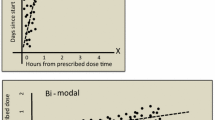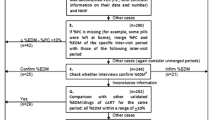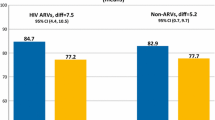Abstract
Medication adherence studies increasingly collect data electronically, often using Medication Event Monitoring System (MEMS) caps. Analyses typically focus on summary adherence measures, although more complete analyses are possible using adaptive statistical methods. These methods were used to describe individual-subject adherence patterns for MEMS data from a clinical trial. Subjects were adaptively clustered into groups with similar adherence patterns and clusters were compared on a variety of subject characteristics. There were seven different adherence clusters: consistently high, consistently moderately high, consistently moderate, consistently moderately low, consistently low, deteriorating starting early, and deteriorating late. Compared to other subjects, subjects with consistently high and consistently moderately high adherence were more likely to be male, White, and older and to maintain during study participation a CD4 cell count over 500 and an HIV viral load of at most 400 copies/ml. These results demonstrate the effectiveness of adaptive methods for comprehensive analysis of MEMS data.














Similar content being viewed by others
References
Ahn, J., McCombs, J. S., Jung, C., Croudace, T. J., McDonnell, D., Ascher-Svanum, A., et al. (2008). Classifying patients by antipsychotic adherence patterns using latent class analysis: Characteristics of nonadherent groups in the California Medicaid Program. Value in Health, 11, 48–56.
Bangsberg, D. R. (2006). Less than 95% adherence to nonnucleoside reverse-transcriptase inhibitor therapy can lead to viral suppression. Clinical Infectious Diseases, 43, 939–941. doi:10.1086/507526.
Bangsberg, D. R. (2008). Preventing HIV antiretroviral resistance through better monitoring of treatment adherence. The Journal of Infectious Diseases, 197, S272–S278. doi:10.1086/533415.
Bova, C., Fennie, K. P., Dieckhaus, K., Knafl, G. J., Watrous, E., & Williams, A. B. (2005). Use of electronic monitoring devices to measure antiretroviral adherence: Practical considerations. AIDS and Behavior, 9, 103–110. doi:10.1007/s10461-005-1685-0.
Delucchi, K., Knafl, G., Haug, N., & Sorensen, J. (2006). Adaptive Poisson modeling of medication adherence among HIV-positive methadone patients. In 2006 proceedings of the American Statistical Association, section on statistics in epidemiology (pp. 2525–2527). Alexandria: American Statistical Association.
Fletcher, C. V., Testa, M. A., Brundage, R. C., Chesney, M. A., Haubrich, R., Acosta, E. P., et al. (2005). Four measures of antiretroviral medication adherence and virologic response in AIDS Clinical Trials Group Study 359. Journal of Acquired Immune Deficiency Syndromes, 40, 301–306. doi:10.1097/01.qai.0000180078.53321.6a.
Gardner, E. M., Sharma, S., Peng, G., Hullsiek, K. H., Burman, W. J., MacArthur, R. D., et al. (2008). Differential adherence to combination antiretroviral therapy is associated with virological failure with resistance. AIDS (London, England), 22, 75–82.
Gerbino, P. P., & Shoheiber, O. (2007). Adherence patterns among patients treated with fixed-dose combination versus separate antihypertensive agents. American Journal of Health-System Pharmacy, 64, 1279–1283. doi:10.2146/ajhp060434.
Holzemer, W. L., Bakken, S., Portillo, C. J., Grimes, R., Welch, J., Wantland, S., et al. (2006). Testing a nurse-tailored HIV medication adherence intervention. Nursing Research, 55, 189–197. doi:10.1097/00006199-200605000-00005.
Knafl, G. J., Fennie, K. P., Bova, C., Dieckhaus, K., & Williams, A. B. (2004). Electronic monitoring device event modelling on an individual-subject basis using adaptive Poisson regression. Statistics in Medicine, 23, 783–801. doi:10.1002/sim.1624.
Knafl, G. J., Fennie, K. P., & O’Malley, J. P. (2006). Adaptive repeated measures modeling using likelihood cross-validation. In B. Bovaruchuk (Ed.), Proceedings second IASTED international conference on computational intelligence (pp. 422–427). Anaheim: ACTA Press.
Knafl, G. J., & Grey, M. (2007). Factor analysis model evaluation through likelihood cross-validation. Statistical Methods in Medical Research, 16, 77–102. doi:10.1177/0962280206070649.
Liu, H., Miller, L. G., Hays, R. D., Golin, C. E., Wu, T., Wenger, N. S., et al. (2006). Repeated measures longitudinal analyses of HIV virologic response as a function of percent adherence, dose timing, genotypic sensitivity, and other factors. Journal of Acquired Immune Deficiency Syndromes, 41, 315–322. doi:10.1097/01.qai.0000197071.77482.6e.
Low-Beer, S., Yip, B., O’Shaughnessy, M. V., Hogg, R. S., & Montaner, J. S. G. (2000). Adherence to triple therapy and viral load response. Journal of Acquired Immune Deficiency Syndromes, 23, 360–361.
Paterson, D. L., Swindells, S., Mohr, J., Brester, M., Vergis, E. N., Squier, C., et al. (2000). Adherence to protease inhibitor therapy and outcomes in patients with HIV infection. Annals of Internal Medicine, 133, 21–30.
Podsadecki, T. J., Vrijens, B. C., Tousset, E. P., Rode, R. A., & Hanna, G. J. (2007). Decreased adherence to antiretroviral therapy observed prior to transient human immunodeficiency virus type 1 viremia. The Journal of Infectious Diseases, 196, 1773–1778. doi:10.1086/523704.
Royston, P., & Altman, D. G. (1994). Regression using fractional polynomials of continuous covariates: Parsimonious parametric modelling. Applied Statistics, 43, 429–467. doi:10.2307/2986270.
Russell, C. L., Conn, V. S., Ashbaugh, C., Madsen, R., Hayes, K., & Ross, G. (2006). Medication adherence patterns in adult renal transplant recipients. Research in Nursing and Health, 29, 521–532. doi:10.1002/nur.20149.
SAS Institute, Inc. (2004). SAS/STAT 9.1 user’s guide. Cary, NC: SAS Institute.
Sereika, S. M., & Dunbar-Jacob, J. (2001). Analysis of electronic event monitored adherence. In L. E. Burke & I. S. Ockene (Eds.), Compliance in healthcare and research (pp. 139–162). Armonk, NY: Futura Publishing.
Shuter, J. (2008). Forgiveness of non-adherence to HIV-1 antiretroviral therapy. The Journal of Antimicrobial Chemotherapy, 61, 769–773. doi:10.1093/jac/dkn020.
Shuter, J., Salro, J. A., Kanmaz, T. J., Rode, R. A., & Zingman, B. S. (2007). HIV-infected patients receiving lopinavir/ritonavir-based antiretroviral therapy achieve high rates of virologic suppression despite adherence rates less than 95%. Journal of Acquired Immune Deficiency Syndromes, 45, 4–8. doi:10.1097/QAI.0b013e318050d8c2.
Stone, M. (1977). An asymptotic equivalence of choice of model by cross-validation and Akaike’s criterion. Journal of the Royal Statistical Society: Series B, 39, 44–47.
Symons, M. J. (1981). Clustering criteria and multivariate normal mixtures. Biometrics, 37, 35–43. doi:10.2307/2530520.
Vrijens, B., Goetghebeur, E., de Klerk, E., Rode, R., Mayer, S., & Urquhart, J. (2005). Modelling the association between adherence and viral load in HIV-infected patients. Statistics in Medicine, 24, 2719–2731. doi:10.1002/sim.2130.
Williams, A. B., Fennie, K. P., Bova, C. A., Burgess, J. D., Danvers, K. A., & Dieckhaus, K. D. (2006). Home visits to improve adherence to highly active antiretroviral therapy: A randomized clinical trial. Journal of Acquired Immune Deficiency Syndromes, 42, 314–321. doi:10.1097/01.qai.0000221681.60187.88.
Acknowledgments
This work was supported in part by grant R01 AI57043 from the NIAID of the NIH, Oregon Health & Science University’s Oregon Clinical and Translational Research Institute (OCTRI) through grant UL1 RR024140 from the NCRR of the NIH and the NIH Roadmap for Medical Research, Yale University’s Center for Interdisciplinary Research on AIDS (CIRA) through grant P30 MH62294 from the NIMH of the NIH. Collection of the data used in analyses was supported in part by grant R01 NR04744 from the NINR of the NIH, Yale University’s GCRC Program through grant M01 RR00125 from the NCRR of the NIH, and the University of Connecticut Health Center’s GCRC Program through grant M01 RR06192 from the NCRR of the NIH. The content is solely the responsibility of the authors and does not necessarily represent the official views of the NIAID, the NCRR, the NIMH, the NINR, or the NIH.
Author information
Authors and Affiliations
Corresponding author
Rights and permissions
About this article
Cite this article
Knafl, G.J., Bova, C.A., Fennie, K.P. et al. An Analysis of Electronically Monitored Adherence to Antiretroviral Medications. AIDS Behav 14, 755–768 (2010). https://doi.org/10.1007/s10461-008-9512-z
Received:
Accepted:
Published:
Issue Date:
DOI: https://doi.org/10.1007/s10461-008-9512-z




